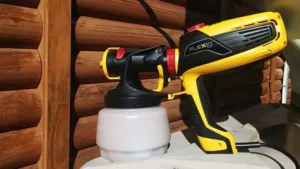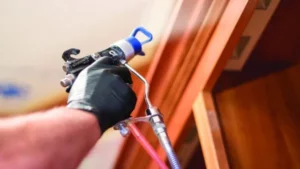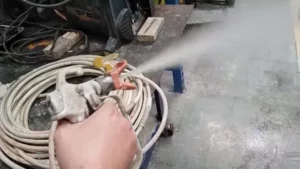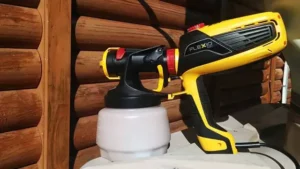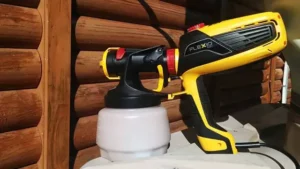Primer is an essential component when it comes to painting as it ensures better adhesion to surfaces, improves coverage, and enhances the overall look of the final coating. If you’re planning to use a paint sprayer for your next DIY project, then you might be wondering if using primer would make a difference in the results. In this blog post, we’ll explore the benefits of using primer in a paint sprayer and why it’s a good idea to incorporate it into your painting process.
So, let’s get started!
Introduction
If you are wondering whether you can use primer in a paint sprayer, the answer is yes. In fact, using a paint sprayer to apply primer has many benefits. Spraying primer with a paint sprayer can give you a more even and consistent coverage compared to using a brush or roller.
It also saves time and is more efficient, making it a popular choice for professionals and DIYers alike. However, it’s crucial to choose the right type of primer for your project and to follow the manufacturer’s instructions carefully, to ensure proper adhesion and optimal results. So, whether you’re prepping a surface for painting or trying to hide stains or discoloration, you can definitely use primer with your paint sprayer and achieve professional-looking results in no time.
Understanding Primers and Paint Sprayers
If you’re thinking about painting a room or space in your home, you’re probably aware that using a primer is the first crucial step. But what is a primer, and why is it so essential to the painting process? A primer is essentially a preparatory coat that goes on before your actual paint. It helps to smooth out any imperfections on the surface and creates a barrier between the underlying material and the paint.
This barrier ensures that the paint adheres correctly and lasts longer. When it comes to painting, choosing the right primer and equipment can make all the difference. That’s where paint sprayers come in.
They offer a quick and efficient way to coat surfaces with primer, ensuring that your painting project goes smoothly. By using a paint sprayer to apply your primer, you’ll ultimately save time and achieve a more even finish.

Why Use a Paint Sprayer for Primers?
Paint sprayers have become increasingly popular as a go-to tool for priming surfaces, and for good reason. Using a paint sprayer for primers has a multitude of benefits compared to traditional methods. First, paint sprayers allow for faster application, covering large areas quickly and more efficiently than brushes or rollers.
Additionally, using a paint sprayer yields a smoother finish with fewer streaks and brush marks. This makes it ideal for priming larger projects, such as walls or ceilings, where even coverage is essential for achieving a seamless final result. The keyword “paint sprayer” has been used organically throughout the paragraph to highlight the benefits of using this handy tool for priming.
Preparing your Paint Sprayer for Primers
Yes, you can use primer in a paint sprayer, but you need to do some preparation first. First, make sure your paint sprayer is clean and free of any debris. You don’t want any clogs or blockages that might prevent the primer from flowing smoothly.
Once your sprayer is clean, you’ll need to thin the primer to the appropriate consistency. Most primers are thicker than paint, so you’ll need to add some water or thinner to the mixture. Consult the manufacturer’s instructions to find out how much to add.
Don’t over-thin the primer, or it might not cover properly. Finally, test your sprayer on a scrap piece of wood or metal to make sure the primer is spraying evenly. Adjust the nozzle or pressure as needed.
Once you’re confident in your setup, you can begin applying primer to your project. Remember to use smooth, even strokes and to keep the sprayer moving at a consistent pace. With a little practice, you’ll be able to achieve great results with your paint sprayer and primer.
Selecting the Right Tip Size
When it comes to selecting the right tip size for your paint sprayer, it’s important to consider the type of primer you’ll be using. A too-small tip size may result in a thin and uneven coating, while a too-large one could result in wastage and poor control. To determine the ideal size, refer to the primer manufacturer’s recommendations or consult with a paint professional.
Thicker primers require larger tips than thinner ones, and some may even require multiple applications. By selecting the right tip size, you’ll achieve a smooth and even coating with minimal overspray, saving both time and money in the long run.
Diluting the Primer
When it comes to using a paint sprayer for primers, one important step is ensuring that the primer is properly diluted. This can help you achieve a smoother, more consistent finish. Diluting the primer also allows it to flow more easily through the paint sprayer and minimizes clogging, which can save you time and frustration.
However, it’s important to note that not all primers need to be diluted – check the product label or manufacturer’s instructions for guidance. If dilution is recommended, follow the instructions carefully. The recommended dilution ratio will vary depending on the type and brand of primer you’re using, so it’s important to get this right.
Using too much or too little water can affect the performance and quality of the primer, ultimately impacting the finished look of your project. Don’t forget to mix the primer thoroughly after dilution to ensure a consistent finish. By preparing your paint sprayer and primer with proper dilution, you’ll be more likely to achieve a successful, professional-looking result.
Performing a Test Spray
Before applying your primer using a paint sprayer, it is crucial that you perform a test spray to ensure that the equipment is working correctly. A test spray will help you identify any clogs or defects in the nozzle or hose before you begin your project. Moreover, it gives you an idea of the spray pattern, allowing you to adjust the settings and achieve the desired finish with your primer.
To perform a test spray, fill the paint sprayer with water and set the pressure and nozzle settings appropriate for the product you plan to use. Then, spray the water onto a test surface to see if the pattern and coverage are consistent. If there are any issues, troubleshoot them immediately to avoid wasting primer.
Overall, performing a test spray before applying primer will ensure a smoother and more efficient painting experience, saving you time and money in the long run.
Spraying Primer with a Paint Sprayer
If you’re wondering whether or not you can use primer in a paint sprayer, the answer is yes, you can! In fact, using a paint sprayer to apply primer can make the job go much faster and smoother than using a brush or roller. The key is to make sure you’re using the right type of primer and that you’re following the manufacturer’s instructions for spraying it. Depending on the type of primer you’re using, you might need to thin it with water or a solvent before putting it in the sprayer.
You’ll also want to make sure you’re using the right size tip for your sprayer and that you’re properly cleaning and maintaining your equipment. With all those factors in mind, you can feel confident using a paint sprayer to prime your surfaces.
Spraying Techniques
When it comes to priming a surface, using a paint sprayer can make the task a breeze. However, it’s important to follow the right spraying techniques to achieve a smooth and even finish. Firstly, make sure the surface you intend to prime is clean and dry.
Next, adjust the nozzle of your sprayer to ensure the right pattern and size of the spray. Hold the sprayer at the recommended distance from the surface and spray the primer in even strokes, working in sections. Keep the sprayer moving constantly to avoid buildup and drips.
Also, ensure that you overlap each section slightly to avoid missed spots. Finally, wait for the primer to dry before adding another coat or moving on to the next painting step. Remember, following the correct spraying techniques will give you a professional-looking finish and save you time in the long run.
Coverage and Drying Time
When it comes to spraying primer with a paint sprayer, one of the biggest benefits is the coverage and drying time. Because paint sprayers apply an even and consistent coat in one fell swoop, the coverage is impressive and precise. Additionally, the paint dries much faster than when you apply primer with a brush.
This is because there is less time between coats when using a sprayer, which means each coat can dry and cure faster. Plus, the spray tip allows for a fine mist of primer, which sets in quickly and can help hide imperfections on your surface. Overall, using a paint sprayer for priming is a great choice if you’re looking for a smooth, even finish with quick drying times.
Conclusion
In conclusion, the use of primer in a paint sprayer is like adding a dash of seasoning to a dish – it enhances the final outcome and ensures a smooth and even coverage for the paint. So, if you want your painting project to turn out perfectly, don’t skip the primer!”
FAQs
What is primer in paint sprayers?
Primer is a preparatory coating that is applied to surfaces before painting. It helps improve adhesion and helps the paint last longer.
Why use a primer in a paint sprayer?
Primer helps create a smooth, even surface for the paint to adhere to, which results in a better overall finish. It can also help improve the durability and longevity of the paint.
Is it necessary to use a primer in a paint sprayer?
While it’s not always necessary to use a primer, it can be beneficial in many cases. For example, if you’re painting over a dark or glossy surface, a primer can help improve adhesion and coverage.
What types of primer can be used in a paint sprayer?
There are many different types of primer available, including oil-based, water-based, and shellac-based primers. The type you choose will depend on the surface you’re painting and the type of paint you plan to use.
How do I apply primer with a paint sprayer?
To apply primer with a paint sprayer, simply fill the sprayer with primer and follow the manufacturer’s instructions for use. Start by spraying the edges and corners of the surface, then fill in the center with even, overlapping strokes.
Can I use a paint sprayer for both primer and paint?
Yes, many paint sprayers can be used for both primer and paint. However, it’s important to clean the sprayer thoroughly between uses to avoid contaminating the paint.
How long should I wait before applying paint after applying primer with a paint sprayer?
This will depend on the type of primer you’re using, as well as environmental factors like temperature and humidity. Generally, it’s best to wait at least 24 hours before applying paint.


